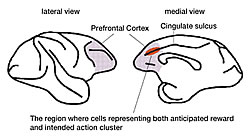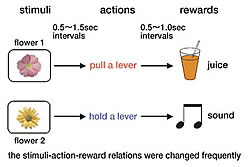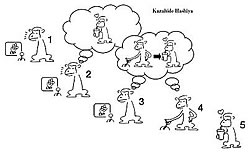The Prefrontal Cortex (PFC) occupies the front half of the frontal lobe and is the area of the cerebrum that regulates complex behaviors. While the functions of the lateral and ventral regions of the PFC have been somewhat well explored, little is known about the function of the medial region.
By repeatedly rewarding a specific action following a stimulus, the association between the stimulus and action becomes firmly fixed in the brain, and a habitual-type behavior develops in which the action is automatically triggered in response to the stimulus. The habitual behavior functions effectively when the behavior takes place in a fixed environment. However, humans and animals occasionally exhibit purposeful behavior. In such cases, the reward that is obtained following the learned stimulus-response behavior comes to mind first. Then, based on the recent experience of action and reward relations, an action is selected and performed. Since learning action-selection based on anticipated reward is faster than learning habitual behavior, the choice of action is more likely to be based on the anticipation of reward when stimuli-action-reward relations change frequently. In order to elucidate mechanisms of action selection based on anticipated reward, monkeys were trained in a behavioral task where frequent changes of conditions take place and nerve cell activity was recorded from various regions of the PFC during the task.
In the behavioral task, two stimuli, two actions, and two rewards were used (Fig. 2). First, one of the two visual stimuli (Flower 1 and Flower 2) was presented on a TV screen, and the monkeys performed one of two actions in response to the stimuli. For Action 1, the monkey pulled the lever; and for Action 2, he remained in the middle position. If the correct response was selected, the monkey was presented with either juice (Reward 1) or a tone (Reward 2). No reward was presented for an incorrect response. To prevent the development of habitual behavior, the stimuli-action-reward relations were changed frequently. Each relationship change required the monkeys to learn new stimuli-action relations by trial and error. After reviewing the behavior of the monkeys in several behavioral experiments, it was clear that the selection of action was based on the anticipation of reward.
Using microelectrodes, nerve cell activity was recorded from various regions of the PFC during task performance. As soon as stimuli were presented, nerve cell activity representing the anticipation of reward appeared extensively around the entire PFC. Following this first type of activity with only 20-30 ms delay, a second type of nerve cell activity, representing both the anticipated reward and intended action, appeared exclusively in the medial region. This second type of cell activity occurred only when a specific reward was anticipated and a particular action was intended. This type of nerve cell activity probably underlies the selection of an appropriate action by evoking the image of an action-reward combination that matches the anticipated reward.
Cell activity indicating the anticipation of reward is known to occur in wide regions of the prefrontal cortex. This study shows that the neuronal process that plays a role in selecting a correct action based upon the anticipation of reward takes place in the medial region of the PFC. The reward is the simplest form of the goal. It is suggested that the medial region of the PFC plays a central role in action-selection process based on goal by having a group of nerve cells representing combinations of particular goals and actions.








